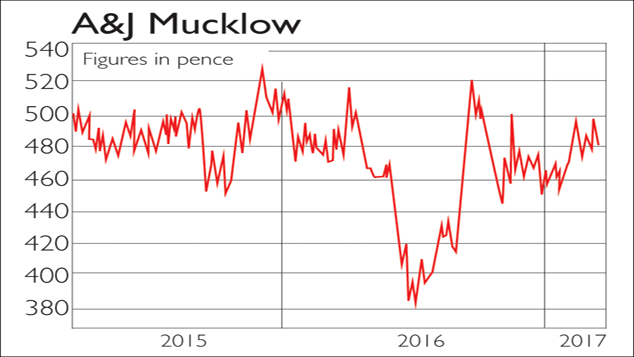Why drones will deliver a boom for warehouses
The first Amazon deliveries by drone have already taken to the air. Technology will give a boost to ecommerce, but investors should buy the infrastructure instead, says Sarah Moore.

The first Amazon deliveries by drone have already taken to the air. Technology will give a boost to ecommerce, but investors should buy the infrastructure instead, says Sarah Moore.
On 7 December last year, consumer history was made here in the UK. A man in Cambridge ordered a bag of popcorn and a TV streaming device from the online retail giant Amazon. Minutes later, a small, electrically powered drone flew out of an Amazon warehouse a few miles from his home and sped across the Cambridge countryside. In all, the delivery the first successful test of Amazon's Prime Air service took 13 minutes from the point of order to the package being dropped off in the customer's garden.
Prime Air is currently available only to two customers in the UK, but Amazon plans to roll it out over the coming months to dozens, then hundreds of people. If successful and given our enthusiasm for the convenience of "just-in-time" delivery services it seems likely that it will be drone delivery will soon be yet another technological marvel that we take for granted. Luckily, even the most jaded among us can profit from the rise of ecommerce by investing in the infrastructure necessary to meet the demands of this expanding business sector.
MoneyWeek
Subscribe to MoneyWeek today and get your first six magazine issues absolutely FREE

Sign up to Money Morning
Don't miss the latest investment and personal finances news, market analysis, plus money-saving tips with our free twice-daily newsletter
Don't miss the latest investment and personal finances news, market analysis, plus money-saving tips with our free twice-daily newsletter
The rise of ecommerce
As technology has improved, it has become easier, cheaper and quicker to shop online, whether doing a weekly food shop or using Amazon's next-day delivery service to order everything from light bulbs to tins of paint. Online-only clothes retailers, such as Asos, which offer free delivery and free returns, have also made it much simpler to do clothes shopping online. This has transformed the retail landscape. By 2015, online sales accounted for 15% of total UK retail sales, according to the UK Data Service.
Meanwhile, last year, consumers spent £133bn with UK retailers online, up 15.7% on the year before, according to the IMRG Capgemini eRetail Sales Index. Nearly half of those sales were made via smartphones. Worldwide, ecommerce revenues are set to reach $4trn dollars by 2020, says the market research company eMarketer.
Pure online retailers (those with no permanent physical presence on the high street or in out-of-town shopping parks), such as Amazon and Asos, account for nearly half of all online sales, according to the Office for National Statistics, with traditional high-street chains making up the rest. But it's not just retailers who are taking advantage of the rapid growth of ecommerce. Dozens of other companies have sprung up over the past decade to provide services to the online retail sector.
Payment-processing companies such as Worldpay and Earthport enable retailers to process large numbers of customer payments. "Big data" companies such as Fusionex help retailers to process, analyse and exploit information on customers' buying habits in order to improve customer loyalty and drive more purchases. Software providers such as dotDigital allow customers to connect to ecommerce platforms. And ecommerce has been a boon for delivery companies such as Wincanton that physically transport goods from A to B.
However, one of the most straightforward ways to profit from ecommerce is to invest in warehouses (see below). People expect to be able to choose from a wide range of goods when they shop online and they expect those goods to be delivered promptly. That in turn requires vast amounts of storage space. Property developers estimate that for every £1bn that consumers spend online, the amount of warehouse space required to meet demand grows by about 930,000 square feet, reports Rhiannon Bury in The Daily Telegraph.
Online sales in the UK are expected to grow by as much as £18bn between 2016 and 2019, according to Europe Real Estate. This suggests that internet retailers will need to find another 17 million sq ft or so of warehouse space in the UK over the next few years.
A space shortage
Given those figures, it's not surprising that the take-up of industrial property reached record highs in 2015, according to the property consultancy Lambert Smith Hampton (LSH). New leases were signed for 44.4m sq ft of space across the UK, an increase of 2m sq ft on the year before. Roughly 12% of this demand came from internet retailers, notes Bury four times as much as in 2009. Of this, Amazon leased 15 buildings, totalling 2.4m sq ft, equivalent to 5% of the market. And it's not just about rising demand. Supply is tight too. The supply of available industrial and logistics space in the UK fell from a peak of 360m sq ft in 2012 to a record low of 200m sq ft in 2015.
As you might expect, the supply of industrial property is especially low in London. About 700 hectares of industrial land has been lost in Greater London as locations such as Nine Elms, Old Oak Common and the Olympic Park have become residential areas, according to Alan Holland of the property developer Segro. "That's the equivalent of seven times the size of Regent's Park it's gone and it won't be replaced," he told Property Week recently. In London and the southeast, the supply of such space was down by 31% in the year to January, according to Savills.
Warehouses are sprouting to meet this demand. As of January, more than 13m sq ft of space is at the "design and build" phase, says commercial real-estate company CBRE. This is partly made up of 3m sq ft in the West Midlands, 3m sq ft in the southeast and 2.4m sq ft in the East Midlands. A further 1m sq ft of speculative development is expected in the southeast, and 1.5m sq ft in the West Midlands. Promised government plans to speed up the planning process and to simplify planning permission should also help developers get warehouses approved and built more quickly and easily.
However, even if current levels of development continue, demand for industrial space will still exceed supply by 25m sq ft by the end of the decade, says LSH. "Unless developers start building warehouses at a rate that we haven't witnessed during the 20 years I've been working in the sector, or major occupiers like Amazon are prepared to wait 12 months for delivery by building it themselves, we could run out of logistics space before the end of the decade", says Steve Williams, head of industrial and logistics at LSH.
Why industrial property?
This lack of supply and strong occupier demand has meant that occupiers have had to pay consistently high and rising rents, says estate agent Savills. Yet the rental yields available on warehouses are still more attractive than those on commercial property in pricier areas. For example, in January retail warehouses were yielding an average of 5.5%, up from 5.13% just 12 months ago. That's driven partly by post-Brexit-vote concerns hanging over capital values (so driving yields up); but more importantly, it's also driven by rising rental payments. These yields compare favourably with an average yield of 3.25% from West End offices, 4.25% from City offices and 4% from high-street retail units.
Industrial property has other attractions too. Leases tend to be longer than retail or office leases, meaning better visibility of future rental income for investors. For example, the high-street giant Next recently signed a 20-year lease for 264,000 sq ft of warehouse space in Doncaster, South Yorkshire, while the DIY group Screwfix took out a ten-year lease on 552,000 sq ft of space in Lichfield, Staffordshire, according to CBRE data.
Depreciation expenses the cost of making good wear and tear on the building tend to be lower for industrial property than for other forms of commercial property, says Jonathan Holland of the property fund manager Legal & General. This means that owners don't have to put as much effort or money into keeping warehouses looking brand new. "Whereas offices need regular upgrading, it is not difficult to find a tenant for a 20-year-old warehouse". Another plus is that commercial property has traditionally proved a good hedge against inflation.
Industrial property lease agreements typically include clauses that guarantee upward-only, inflation-linked rent increases. This offers useful protection for investors who are concerned that we might be heading for a more inflationary future.
So in addition to rising demand as we choose to shop online more, well-chosen warehouses should offers a number of other attractions. Below we look at some of the best ways to invest in industrial property.
How to buy a warehouse
The "golden triangle" of warehouses, as it's apparently called in the industry, is found in the Midlands. Specifically, it's the area formed by the intersections of the M1, M6 and M42, and it is chock-full of distribution centres, warehouses, freight hubs and fulfilment houses. It's popular with the logistics industry for a couple of reasons.
Firstly, it is only a few hours' drive from most of the UK's big cities. Secondly, land there is still a lot less expensive than in the southeast of England. However, investing in warehouses in urban areas in the southeast can also be lucrative, as space in the region is at such a premium.
Of course, most of us won't be buying our own warehouse to try to let it out to Amazon. A far easier way of investing in industrial property is to get someone else to do it for you, by buying shares in a real estate investment trust (Reit). Reits are companies that develop, invest in and manage property (usually commercial property).
The buildings are rented out and the income is paid to investors in the form of a dividend. Several UK-listed Reits invest in warehouses, either exclusively or as part of a more diverse commercial property portfolio. We look at some promising options below, but here are some general rules to follow when picking a Reit.
Look at the sort of tenants they have on their books. As with residential letting, you are looking for reliable tenants who have the ability to pay their renton time, and who have the financial stability to continue doing so for several years to come. There's not much point in having an upwards-only, inflation-linked, long-term rental contract if the tenant is on the verge of going bust after a bad quarter.
So, examine the accounts of the Reit and its largest tenants as this will give you a good idea of whether the business would be able to put up with economic uncertainty in the future (such as a sharp increase in business rates, for example). Also, check on debt levels ("gearing"). The more indebted the Reit, the more vulnerable it is to rising interest rates, which make debt more expensive to service.
Five of the best plays on commercial property
The industrial developer Segro (LSE: SGRO) completed a record amount of new warehouse space last year 422,000 sq m of which 80% is now let. Developments in progress are expected to bring in £27m of rent a year and there are plans to spend £302m on new developments this year. Last week the firm announced a £556m rights issue to fund a takeover of a portfolio of 21 properties, most of which are at Heathrow airport.
The AEW UK (LSE: AEWU) Reit invests in smaller UK commercial properties. Although the portfolio is fairly evenly split between offices, industrial property and retail property, the managers "foresee the best returns to be in the industrial and logistics sector". The fund is diversified outside of London and the southeast, with significant weightings to the southwest, the Midlands, and Yorkshire and Humberside. AEWU trades at a fairly narrow 0.5% discount to its net asset value (NAV the value of the underlying portfolio), but it yields an impressive 8.1%.
The focus of LondonMetric (LSE: LMP) has changed over the past few years. Previously, the Reit's property portfolio had a fairly balanced weighting to most commercial-property sectors (London-based offices, retail, residential and logistics). But it has shifted towards investing more heavily in the sectors that it believes are "benefiting most from structural change". This decision has taken it firmly into the logistics sector. CEO Andrew Jones is confident shoppers will continue to migrate online, regardless of political or economic events.
As a result, LMP now has 59% of its portfolio in distribution properties, compared with 17% in retail parks. The portfolio is fairly evenly spread across the UK, with properties as far apart as Cornwall, Inverness and the Isle of Man. It yields 5%.
Schroder Real Estate Investment Trust (LSE: SREI) has only a 23% weighting to industrial property, but it is also geographically well diversified with plenty of exposure to the Midlands and Wales (26%), and the north and Scotland (27%) and currently trades at a 4.3% discount to its net asset value.

A&J Mucklow (LSE: MKLW) has been around since 1933. This Reit focuses on industrial property in the West Midlands and aims to take advantage of the lack of supply in the local market. The share price fell sharply last summer, as a result of the panic in the commercial property market after the referendum on Britain's membership of the European Union.
The price has since recovered strongly, and the stock still offers a relatively attractive dividend yield of 5%. Fund manager Gervais Williams recommended A&J Mucklow in MoneyWeek last year as a play on "reshoring" companies bringing their manufacturing activities back to the United Kingdom.
Get the latest financial news, insights and expert analysis from our award-winning MoneyWeek team, to help you understand what really matters when it comes to your finances.
Sarah is MoneyWeek's investment editor. She graduated from the University of Southampton with a BA in English and History, before going on to complete a graduate diploma in law at the College of Law in Guildford. She joined MoneyWeek in 2014 and writes on funds, personal finance, pensions and property.
-
 MoneyWeek news quiz: How much can you win in Premium Bonds?
MoneyWeek news quiz: How much can you win in Premium Bonds?Quiz Premium Bonds, ChatGPT, and the start of the festive season all made headlines this week. How closely were you following the news?
-
 Salary sacrifice pensions cap: 3.3 million workers to be hit by contribution limits
Salary sacrifice pensions cap: 3.3 million workers to be hit by contribution limitsThe government has revealed further details of its controversial cap on pension contributions through salary sacrifice. Here is how the changes could affect you
-
 Governments will sink in a world drowning in debt
Governments will sink in a world drowning in debtCover Story Rising interest rates and soaring inflation will leave many governments with unsustainable debts. Get set for a wave of sovereign defaults, says Jonathan Compton.
-
 Why Australia’s luck is set to run out
Why Australia’s luck is set to run outCover Story A low-quality election campaign in Australia has produced a government with no clear strategy. That’s bad news in an increasingly difficult geopolitical environment, says Philip Pilkington
-
 Why new technology is the future of the construction industry
Why new technology is the future of the construction industryCover Story The construction industry faces many challenges. New technologies from augmented reality and digitisation to exoskeletons and robotics can help solve them. Matthew Partridge reports.
-
 UBI which was once unthinkable is being rolled out around the world. What's going on?
UBI which was once unthinkable is being rolled out around the world. What's going on?Cover Story Universal basic income, the idea that everyone should be paid a liveable income by the state, no strings attached, was once for the birds. Now it seems it’s on the brink of being rolled out, says Stuart Watkins.
-
 Inflation is here to stay: it’s time to protect your portfolio
Inflation is here to stay: it’s time to protect your portfolioCover Story Unlike in 2008, widespread money printing and government spending are pushing up prices. Central banks can’t raise interest rates because the world can’t afford it, says John Stepek. Here’s what happens next
-
 Will Biden’s stimulus package fuel global inflation – and how can you protect your wealth?
Will Biden’s stimulus package fuel global inflation – and how can you protect your wealth?Cover Story Joe Biden’s latest stimulus package threatens to fuel inflation around the globe. What should investors do?
-
 What the race for the White House means for your money
What the race for the White House means for your moneyCover Story American voters are about to decide whether Donald Trump or Joe Biden will take the oath of office on 20 January. Matthew Partridge explains how various election scenarios could affect your portfolio.
-
 What’s worse: monopoly power or government intervention?
What’s worse: monopoly power or government intervention?Cover Story Politicians of all stripes increasingly agree with Karl Marx on one point – that monopolies are an inevitable consequence of free-market capitalism, and must be broken up. Are they right? Stuart Watkins isn’t so sure.